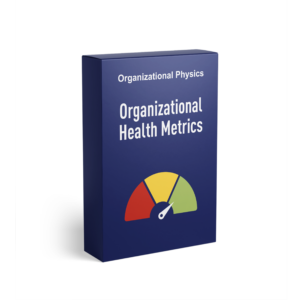 Organizational Health Metrics is used in the Designed to Scale Coaching Program. Its purpose is to create a custom organizational health dashboard that reflects your company’s current health as well as where its leading indicators are pointing so that you can take action before it becomes a problem.
Organizational Health Metrics is used in the Designed to Scale Coaching Program. Its purpose is to create a custom organizational health dashboard that reflects your company’s current health as well as where its leading indicators are pointing so that you can take action before it becomes a problem.
Prerequisites for this program are that the company has its Top-Level OKRs and Evolving Structure in place, as well as its core set of Targets & KPIs.
Organizational Health Metrics mean just what they sound like. A set of rolled-up, top-level dashboard metrics that reflect how healthy the organization is now, as well as where its leading indicators are pointing it.
Monthly and weekly health metrics are reviewed as a team at the weekly Leadership Team meetings. Here, hot items are identified and assigned for fact-finding and resolution. Health metrics strongly influence the development and execution of the company’s OKRs in Cascading Objectives. It is Organizational Health Metrics that connects the two:
It can be difficult to assess organizational health without falling into a trap. It’s the trap of trying to track too many things. If you go to the doctor to get a scan and get back 150 data points, you’re not likely to be able to figure out where you should focus on improving your health. Same thing here.
In this program, we consult with you to define the most important 25 to 30 top-level health metrics total, across six categories:
Using your company’s lifecycle stage, structure, targets, and key performance indicators, we develop a customized organizational health dashboard for you to review and adjust together.
In the Leadership Team facilitator training program, I will observe how the organizational health dashboard review sessions go via video recordings. You’ll continue to use your existing business intelligence dashboard software (Tableau, BI, etc.). If you don’t have one yet, you can use my free version until you’re ready to upgrade to a platform of your choice.
1. Do these metrics track OKR performance?
OKR performance shouldn’t be tracked on this dashboard. Cascading Objectives handles that separately. The dashboard should reflect organizational health, which includes current business operations, while OKRs focus on business transformation.
2. We already have a dashboard. Why would we need this?
There is a possibility that you won’t need this. We haven’t yet seen a dashboard that we couldn’t improve a bit for this particular purpose of tracking organizational health.
3. We lack automated tracking and reporting. Is this program premature?
The truth is, you can’t afford to operate as a business without automated tracking and reporting for all business functions for much longer. When you have this dashboard laid out in advance, you can add automated tracking and reporting in a very focused way. As in, “We must finish the metrics for this dashboard first! Then we can move on to other metrics…”
If you like this way of thinking and want to engage in a similar process for your company, schedule a consultation.

Let’s build your high-performance organization together.
Organizational Physics® empowers CEOs and leadership teams to scale with clarity and confidence. By applying universal principles and proven frameworks, we help organizations improve internal performance, accelerate growth, and build resilient structures for the long term.
© Copyright Organizational Physics Inc.